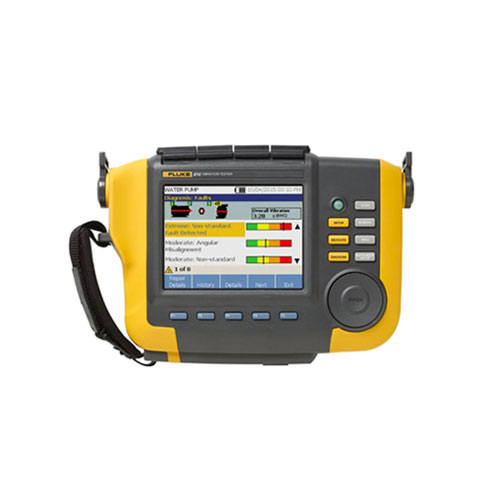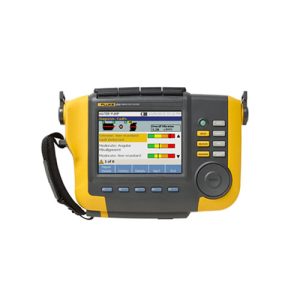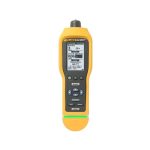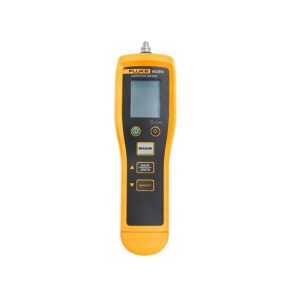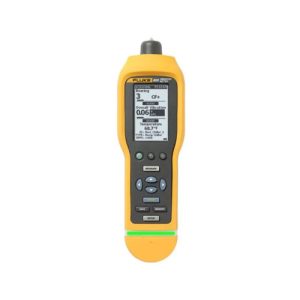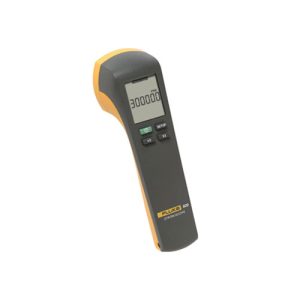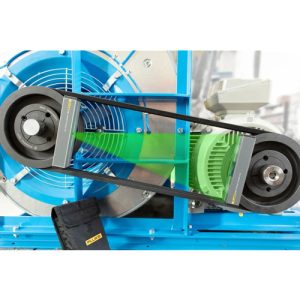Fluke 810 Vibration Tester
- On-board identification and location of the most common mechanical faults (bearings, misalignment, unbalance, looseness) focus maintenance efforts on root cause, reducing unplanned downtime
- Overall vibration level allows you to quickly assess overall machine health directly from the diagnosis screen
- Fault severity scale with four severity levels helps you prioritize maintenance work
- Repair recommendations advise technicians on corrective action
- Detailed diagnostic reports and spectral diagrams help confirm data quality, and narrow down the root cause of failures
- On-board context sensitive help provides real-time tips and guidance to new users
- Description
- Additional information
- Specifications
Description
Let’s talk about the Fluke 810 Vibration Tester. Imagine you’re a doctor for machines. A simple vibration meter is like taking a patient’s temperature – it tells you something’s up, but not exactly what. The Fluke 810 is like having an X-ray, MRI, and a specialist’s consultation all in one. It dives deep into the vibrations of your equipment to pinpoint the why behind the shaking, rattling, and rolling.
Here’s a closer look at what makes the Fluke 810 so effective and easy to use:
- Smart Diagnostics: The 810 doesn’t just measure vibration levels; it analyzes the data to tell you exactly what’s wrong. It identifies common culprits like imbalance, misalignment, looseness, and bearing defects, and often even suggests possible solutions.
- Crystal-Clear Display: No need to decipher complex charts. The 810 presents diagnostic information in a clear, concise way, so you can quickly understand the problem and its severity.
- It’s designed for real-world maintenance professionals, not vibration experts.
- Comprehensive Data: The included tri-axial accelerometer measures vibration in three directions simultaneously, giving you a complete picture of the machine’s condition. This is far more informative than a single-axis measurement.
- Flexible Operation: The 810 offers two modes: a quick “screening” mode for checking multiple machines rapidly, and a more in-depth “diagnostic” mode for detailed analysis of specific issues.
- Keeps Track of Changes: The 810 stores vibration data, allowing you to track trends over time. This helps you spot developing problems before they become critical failures, letting you schedule maintenance proactively.
- Easy Reporting: You can generate reports and transfer data to a computer for further analysis, documentation, and sharing with your team. This streamlines maintenance planning and helps you track the effectiveness of repairs.
In simple terms, the Fluke 810 helps you:
- Identify the Root Cause: It pinpoints the exact reason for excessive vibration, not just that it exists.
- Save Time and Money: Targeted maintenance means less downtime, fewer unnecessary repairs, and a more efficient use of your resources.
- Prevent Costly Breakdowns: Catching problems early prevents them from escalating into major, expensive failures.
- Extend Equipment Lifespan: Proper maintenance, guided by accurate diagnostics, helps keep your machines running smoothly for longer.
Additional information
| Brand | Fluke |
|---|
Specifications: Fluke 810 Vibration Tester
| Diagnostic Specifications | |
| Standard Faults | Unbalance, looseness, misalignment and bearing failures |
| Analysis For | Motors, fans, blowers, belts and chain drives, gearboxes, couplings, centrifugal pumps, piston pumps, sliding vane pumps, propeller pumps, screw pumps, rotary thread/gear/lobe pumps, piston compressors, centrifugal compressors, screw compressors, closed coupled machines, spindles |
| Motor Rotational Speed Range | 200 rpm to 12000 rpm |
| Diagnosis Details | Plain-text diagnosis, fault severity (slight, moderate, serious, extreme), repair details, cited peaks, spectra |
| Electrical Specifications | |
| Ranging | Automatic |
| A/D Converter | 4 channel, 24 bit |
| Usable Bandwidth | 2 Hz to 20 kHz |
| Sampling | 51.2 Hz |
| Digital Signal Processing Functions | Automatically configured anti-alias filter, high-pass filter, decimation, overlapping, windowing, FFT, and averaging |
| Sampling Rate | 2.5 kHz to 50 kHz |
| Dynamic Range | 128 dB |
| Signal To Noise Ratio | 100 dB |
| FFT Resolution | 800 lines |
| Spectral Windows | Hanning |
| Frequency Units | Hz, orders, cpm |
| Amplitude Units | in/sec, mm/sec, VdB (US), VdB* (Europe) |
| Non-volatile Memory | SD micro memory card, 2 GB internal + user accessible slot for additional storage |
| General Specifications | ||
| Dimensions (H x D x W) | 18.56 x 7.00 x 26.72 cm (7.30 x 2.76 x 10.52 in) | |
| Weight (With Battery) | 1.9 kg (4.2 lb) | |
| Display | ¼ VGA, 320 × 240 Color (5.7 inch diagonal) TFT LCD with LED backlight | |
| Input/Output Connections | Triaxial sensor connection | 4 pin M12 connector |
| Single axis sensor connection | BNC connector | |
| Tachometer Connection | Mini DIN 6 pin connector | |
| PC Connection | Mini ‘B’ USB (2.0) connector | |
| Battery | Battery type | Lithium-ion, 14.8 V, 2.55 Ah |
| Battery charging time | Three hours | |
| Battery discharge time | Eight hours (under normal conditions) | |
| AC Adapter | Input voltage | 100 VAC to 240 VAC |
| Input frequency | 50/60 Hz | |
| Operating System | WinCE 6.0 Core | |
| Language Support | English, French, German, Italian, Japanese, Portuguese, Simplified Chinese, Spanish | |
| Warranty | Three-years | |
| Environmental Specifications | |
| Operating Temperature | 0°C to 50°C (32°F to 122°F) |
| Storage Temperature | -20°C to 60°C (-4°F to 140°F) |
| Operating Humidity | 10% to 95% RH (non-condensing) |
| Agency Approvals | CHINA RoHS, CSA, CE, C TICK, WEEE |
| Electromagnetic Compatibility | EN 61326-1:2006, EN 61010:1:2001 2nd ed. |
| Sensor Specifications | ||
| Sensor Type | Accelerometer | |
| Sensitivity | 100 mV/g (±5%, 25°C) | |
| Acceleration Range | 80 g peak | |
| Amplitude Nonlinearity | 1% | |
| Frequency Response | Z | 2 – 7,000 Hz ±3dB |
| X, Y | 2 – 5,000 Hz ±3dB | |
| Power Requirement (IEPE) | 18 VDC to 30 VDC, 2 mA to 10 mA | |
| Bias Output Voltage | 12 VDC | |
| Grounding | Case grounded | |
| Sensing Element Design | PZT ceramic / shear | |
| Case Material | 316L stainless steel | |
| Mounting | 10-32 captive socket head screw, 2-pole rare earth magnet (48 lb pull strength) | |
| Output Connector | 4-Pin, M12 | |
| Mating Connector | M12 – F4D | |
| Non-volatile Memory | TEDS 1451.4 compatible | |
| Vibration Limit | 500 g peak | |
| Shock Limit | 5000 g peak | |
| Electromagnetic Sensitivity, Equivalent g | 100 μg/gauss | |
| Sealing | Hermetic | |
| Temperature Range | -50°C to 120°C (-58°F to 248°F) ±7% | |
| Warranty | One-year | |
| Tachometer Specifications | ||
| Dimensions (D x W) | 2.86 x 12.19 cm (1.125 x 4.80 in) | |
| Weight | 96 g (3.4 oz) with cable | |
| Power | Powered by 810 Vibration Tester | |
| Detection | Laser Diode Class 2 | |
| Range | 6.0 to 99,999 rpm | |
| Accuracy | 6.0 to 5999.9 rpm | ±0.01% and ±1 digit |
| 5999.9 to 99999 rpm | ±0.05% and ±1 digit | |
| Resolution | 0.1 rpm | |
| Effective Range | 1 cm to 100 cm (0.4 in to 39.27 in) | |
| Response Time | 1 second (> 60 rpm) | |
| Controls | Measure on/off transparent button | |
| Interface | 6 Pin Mini DIN | |
| Cable Length | 50 cm (19.586 in) | |
| Warranty | One-year | |
| Tachometer Accessories | Reflective tape | 1.5 x 52.5 cm (0.59 x 20.67 in) |




















